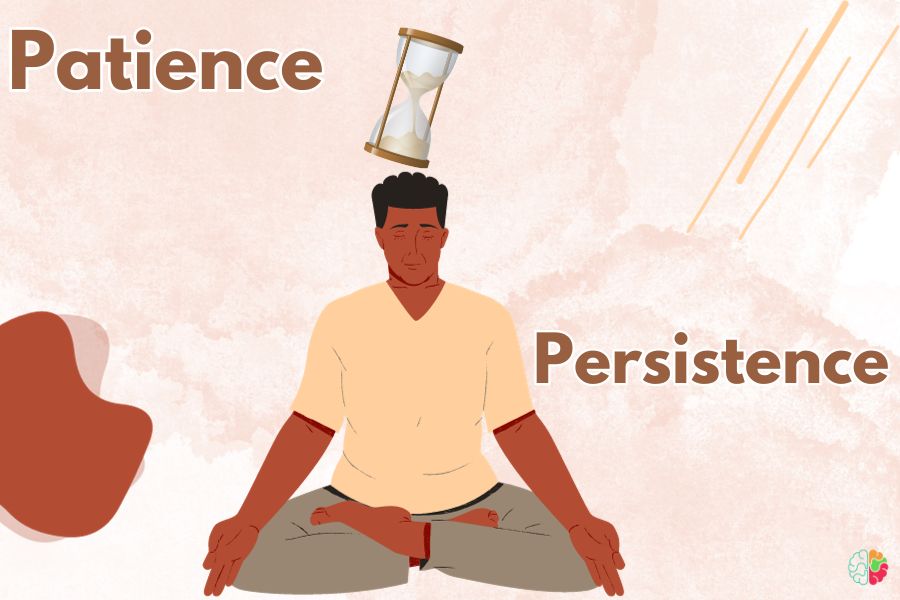Table of Contents
Are you prepared to go off on a life-changing adventure of healing, self-discovery, and development?
Shadow Work has become increasingly well-liked in recent years as a useful technique for uncovering our psyche’s hidden facets, facing our inner demons, and eventually embracing our true selves.
However, many people ask, “Is shadow work dangerous?” This essay will explore the world of shadow work, its history, and most importantly, provide you with 15 safe and efficient ways to use it.
So let’s illuminate the inside darkness and discover how to manage this transformational process.
Watch this video to learn more about shadow work:
Understanding Shadow Work: Unveiling the Shadows Within
The technique of “shadow work” involves intense introspection and explores the parts of our brain that we frequently suppress or reject.
The Swiss psychiatrist Carl Jung made the term “shadow” well-known because he thought our subconscious minds contained hidden facets of our personalities.
Unresolved traumas, fears, and repressed feelings are frequently included in these elements. Shadow work entails facing and integrating these unseen components into our waking awareness.
Shadow work has been used historically by many different spiritual traditions and cultural groups in a variety of ways.
The purpose of alchemy was to turn base elements into gold, which served as a metaphor for one’s own metamorphosis.
Similar to this, meditation and introspection are encouraged in Eastern philosophies like Buddhism in order to identify and resolve internal conflicts.
Shadow work is now accepted as a technique for fostering emotional healing and personal development across a range of psychological and self-help professions.
You might also enjoy: How to Glow Up Mentally and physically: Top 25 Ways [2024]
The Evolution of Shadow Work
Shadow work now includes a range of methods and techniques thanks to its long history of evolution.
It has advanced past psychology to become a comprehensive plan for personal development. The history of shadow work is summarized in the following manner:
- Psychoanalytic Roots: Carl Jung’s work in the early twentieth century created the groundwork for contemporary shadow work.
He proposed the concept of the “shadow” as a component of the unconscious mind comprising suppressed and unwanted qualities.
Jung thought that integrating the shadow might lead to personal progress and a more balanced mentality. - Inner Child Work: The 20th century saw the emergence of inner child work as a significant component of shadow work.
This method puts a strong emphasis on mending past traumas and tending to childhood scars.
It underlines how crucial it is to raise and rear your inner child in order to experience emotional healing and personal growth. - New Age and Spiritual Movements: The New Age movement made several types of spiritual shadow work commonplace in the second half of the 20th century.
For the purpose of fostering spiritual and personal development, methods including shamanism, energy healing, and meditation were incorporated into shadow work. - Integrative Psychology: Shadow work is now accepted in modern psychology and therapy.
To help people examine their shadows and achieve emotional healing and personal growth, therapists and counselors combine approaches like cognitive-behavioral therapy and mindfulness.
The question of “Is shadow work dangerous?” arises as we learn more about this practice.
It is essential to tread this route cautiously even if it has the potential to be a powerful tool for transformation.
In the sections that follow, we’ll take a closer look at 15 techniques for conducting shadow work safely.
You might also enjoy: How To Feel Alive Again: 20 Powerful Ways [2024]
15 Ways To Practice Shadow Work Safely
After defining shadow labor and tracing its historical development, let’s examine 15 ways to conduct it securely and efficiently.
These techniques will enable you to set out on your journey with self-assurance and confidence, allowing you to embrace the transforming power of shadow work while reducing the hazards.
1. Educate Yourself
You must first familiarize yourself with the nuances of shadow work before setting out on a fruitful and secure voyage into the depths of your shadow.
Understanding the ideas, procedures, and potential difficulties associated with engaging your subconscious self is necessary for this self-guided inquiry.
You may traverse this inner trip more skillfully and confidently if you take an informed approach.
Start by reading books that explore the subject of shadow work.
Numerous publications authored by professionals and practitioners in the discipline provide insightful analysis and useful exercises.
Shadow work-related seminars and workshops can be quite insightful. These gatherings frequently offer a venue for interaction with knowledgeable people and the acquisition of firsthand information.
Additionally, consulting with therapists or counselors who specialize in shadow work can provide you with a qualified viewpoint and individualized plans to guarantee your safety during the procedure.
You will be more equipped to confront the internal shadows the more you immerse yourself in the theoretical facets of shadow work.
You might also enjoy: Blame Shifting: What Is It + 15 Solutions For It [2024]
2. Seek Professional Guidance
While shadow work can certainly be embarked upon independently, there’s immense benefit in seeking the expertise and support of a qualified therapist or counselor.
These professionals are well-versed in guiding individuals through the intricate terrain of shadow work, offering a safe and supportive environment for your journey.
The experience and training required to assist you in navigating the difficult emotional landscapes that may emerge during your shadow work are available from licensed therapists and counselors.
They may offer priceless perceptions that help you comprehend your repressed feelings, anxieties, and traumas better.
Professional advice is essential to ensuring your safety during the process because many times these concealed features can be really intense.
These experts can serve as a stabilizing factor, enabling you to face your fears while maintaining emotional equilibrium.
The voyage becomes less dangerous and more gratifying with their assistance.
You might also enjoy: 30 Best Emotional Goals For Having An Amazing 2024
3. Start Small
It’s not necessary for shadow work to be a laborious, all-consuming task.
In reality, it’s frequently more efficient to take baby steps toward exploring deeper aspects of your personality.
Start by talking about the little things or parts of yourself that you’re ready to explore.
As you advance along your journey, this methodical technique enables you to increase your self-assurance and resiliency.
Taking small steps allows you to adjust to the emotional intensity that often accompanies shadow work.
By conquering less daunting elements first, you will gain power over your emotions and thoughts, preparing you to confront deeper, more difficult shadow aspects when you are ready.
You might also enjoy: Why Am I Bad at Everything? 17 Psychological Reasons You Are Wrong!
4. Create a Safe Space
Your safety and comfort throughout the shadow work process are greatly influenced by the environment in which you participate.
Choose a calm, relaxing setting where you can concentrate on your task undisturbed and completely enjoy it. For best results, a focused and secure environment is necessary.
Creating rituals or routines can improve the security and efficacy of your shadow job.
To feel anchored and comfortable, try lighting a candle, listening to soothing music, or doing deep breathing exercises.
These routines operate as anchors, giving you a sense of security throughout the occasionally tumultuous emotional trip of shadow work.
You can create an atmosphere where you are fully supported in your inner inquiry by creating a safe area.
You might also enjoy: Why Do I Suck At Everything? 20 Helpful Tips To Erase It!
5. Practice Self-Compassion
You could discover aspects of yourself that are difficult to embrace when you explore further into your psyche.
A high amount of self-compassion must be maintained during this process.
Essentially, you should treat yourself with the same compassion and consideration that you would extend to a good friend.
Shadow work has the power to arouse strong feelings and reveal long-buried trauma or pain.
It’s simple to be harsh or judgmental when these components of your shadow self emerge. But putting self-compassion into practice entails giving oneself acceptance, love, and forgiveness.
Recognize that facing your shadows is a brave act of self-love and personal development.
You encourage the healing process to proceed in a compassionate and supportive way by being kind and patient with yourself.
You might also enjoy: What Is Emotion Scale + 7 Different Types Of It
6. Embrace Mindfulness
For shadow work, mindfulness is a powerful tool. It entails remaining mindful of your thoughts, feelings, and experiences in the moment without passing judgment on them.
During your inner inquiry, you may come across challenging feelings, memories, or repressed facets of your personality. When this happens, approach them mindfully.
Shadow labor benefits greatly from the use of mindfulness. It entails remaining mindful of your thoughts, feelings, and experiences as they come to you in the present moment, without passing judgment.
During your inner journey, be alert when you come across challenging feelings, memories, or repressed components of your personality.
7. Journal Your Experiences
Keeping a journal of your shadow work journey can be an immensely beneficial practice.
Writing down your thoughts, emotions, and experiences allows you to gain clarity and insight into your inner world.
It serves as a record of your progress, enabling you to track your growth over time.
Through journaling, you can explore the patterns and themes that emerge during your shadow work.
It provides an opportunity to reflect on your experiences, gain perspective, and uncover underlying beliefs and emotions.
The act of writing is therapeutic in itself and can be a grounding practice throughout your shadow work process, helping you maintain a strong connection with your evolving self.
You might also enjoy: Monk Mode: What Is It? 10 Ways To Implement It
8. Practice Self-Care
Focusing on self-care is essential when dealing with deep emotions and unresolved difficulties. Engage in activities that improve your physical, emotional, and mental health.
Self-care, whether through exercise, meditation, creative expression, or spending quality time with loved ones, is essential to maintaining balance and resilience throughout life’s work.
You can get the assistance and nutrition you need from self-care practices to deal with any potential emotional intensity.
Particularly when it comes to releasing suppressed emotions and fostering emotional stability, physical activity can be a very helpful outlet.
You will be better prepared to navigate your path through shadow work efficiently and safely if you engage in activities that help you unwind and refresh.
9. Set Boundaries
Setting boundaries is crucial when doing shadow work. Even if you wish to explore your shadow, it’s crucial to be aware of and respect your boundaries.
There’s no need to overextend yourself or plunge into challenges you’re not prepared for. You’ll preserve a sense of security and control over your journey by establishing defined boundaries.
These limits might come in a variety of shapes. To avoid feeling overwhelmed, you could set time restrictions for your shadow work sessions.
As you gain comfort you can gradually expand your boundaries by defining the precise subjects or feelings you’re willing to explore at a given time.
Setting boundaries helps to prevent emotional stress or burnout and to keep your shadow work a process in which you have agency.
You might also enjoy: Self-Control is Strength. Calmness Is Mastery. You – Tymoff
10. Embrace Integration
Shadow work focuses on integrating your shadows into your entire self rather than trying to get rid of them.
Accepting all facets of who you are, even those you may have previously denied or rejected entails embracing the shadow.
The development of completeness and self-acceptance, which eventually result in personal development and healing, depends on this integration.
The purpose of shadow work is to bring your shadow personality traits into conscious consciousness and integrate them into your life, not to completely eliminate them.
You develop a more genuine and well-balanced self by doing this.
These previously undiscovered aspects of who you are can be a source of power, inspiration, and knowledge.
Accepting integration is realizing that your shadows are an essential component of who you are and that becoming aware of them is a transforming step on the path to self-realization.
You might also enjoy: Top 21 Personal Development Blogs in 2024
11. Patience and Persistence
The process of working in the shadows is one that takes time and necessitates perseverance.
It’s not about quick remedies or radical change. Instead, it’s a journey marked by slow development and self-awareness. Be ready for disappointments and uncomfortable moments.
These trying times are a necessary component of the shadow work process and they frequently result in the biggest discoveries.
It is crucial to keep working toward your progress even when things are difficult. Accept patience and have faith in the procedure.
Even the smallest action you do to face your darkness advances your emotional growth and personal growth.
The secret to enjoying the benefits of shadow work and ultimately developing into a more complete and self-aware person is persistence.
12. Connect with a Supportive Community
Interacting with a supportive community of like-minded people can be extremely valuable in your side hustle journey.
Whether you join a local group, participate in online forums, or attend a workshop, connecting with others who share your journey provides guidance, inspiration, and a sense of well-being. deeply familiar.
Insights, inspiration, and a secure place to discuss your experiences can all be found in a caring community.
You can obtain new insights into your shadow work and benefit from the experiences of others.
Furthermore, the feeling of camaraderie can serve as inspiration and drive by serving as a constant reminder that you are not alone on this life-changing journey of self-discovery.
By getting involved in a group, you can build a network of supporters that will assist your development while navigating your shadow work more skillfully.
You might also enjoy: 10 Reasons Why YOU Attract What You Are (2024)
13. Incorporate Creative Expression
Using creative expression as shadow labor is another excellent strategy.
Any type of creative expression—whether it is art, music, dance, or another—can be a potent tool for processing and exploring your shadow sides.
You can access your subconscious mind through creative expression, bringing feelings and thoughts there to the surface.
You can discover that when you communicate aspects of your shadow that are challenging to verbally describe through creative endeavors.
Your inner world can be expressed in a secure, nonjudgmental environment through artistic efforts. Keep an eye out for any symbols, motifs, or themes that develop in your work as you work.
These can assist you in better navigating your self-discovery path and provide insightful information about your shadow selves.
14. Utilize Dream Analysis
The unconscious mind can frequently be accessed through dreams, making dream analysis an important technique for shadow work.
Aspects of your psyche that are buried can be revealed by paying attention to your dreams and their meaning.
Your awake mind may have been unwilling to embrace certain messages, feelings, or memories that may have been present in your dreams.
Keep a dream journal by your bed and as soon as you wake up, write down your dreams.
You might start to pick up on recurring themes, symbols, or characters that reveal information about your shadows over time.
You can obtain deeper insights into your inner world and find unsolved issues that are ready to be addressed in your waking life by investigating the meanings of your dreams.
You might also enjoy: My Wife Yells At Me! 8 Ways To React Properly
15. Practice Forgiveness
One of the most significant aspects of shadow work is forgiveness, which entails making amends with both oneself and others.
You can find old traumas, grudges, or resentments that have been simmering in your mind while you face your inner demons.
These unfavorable feelings might weigh you down and impede your progress and well-being.
You can be freed from the burden of unresolved anger and pain by engaging in a transformative act of forgiveness.
Releasing the hold they have on your emotions and energy does not imply that you are condoning the wrongs of the past.
If you are holding any shame or self-blame, start by forgiving yourself. Consider then asking anyone who may have harmed you in the past for forgiveness.
You can move forward with better clarity and inner peace after engaging in this exercise, which can be emotionally taxing but is also wonderfully freeing.
listening to this podcast is a good way to gain information about shadow work:
Conclusion
So is it risky to work as a shadow? Shadow work can be a difficult and exhausting process emotionally but it doesn’t have to be harmful if done with mindfulness, self-compassion, and a dedication to self-care.
This effective self-healing and self-discovery tool has the capacity to change your life and free you to appreciate who you truly are.
This post has covered the background of shadow work as well as 15 useful tips for doing it safely.
You can start your path into shadow work with confidence and resiliency by educating yourself, getting professional advice, starting small, making a safe environment, and practicing self-compassion.
Keep in mind that shadow work is a profound journey into the depths of your psyche and that it presents a truly transformative chance for personal growth and healing.
Accept your shadows as a part of who you are and watch as you emerge into the clarity of self-awareness and self-acceptance.



![Is Shadow Work Dangerous 15 Ways To Practice It [2024]](https://mindsetopia.com/wp-content/uploads/2023/10/Is-Shadow-Work-Dangerous-15-Ways-To-Practice-It-2024-758x505.jpg)

















![22 Physical Symptoms Of Throat Chakra Opening [2024]](https://mindsetopia.com/wp-content/uploads/2023/10/22-Physical-Symptoms-Of-Throat-Chakra-Opening-2024-150x150.jpg)
